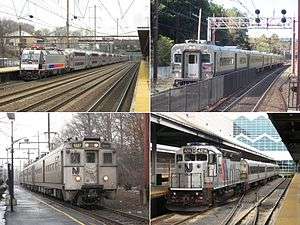Bombardier ALP-45DP
The Bombardier ALP-45DP is a type of single cab dual-mode locomotive built by Bombardier Transportation for use by NJ Transit and Exo.
| ALP-45DP | |||||||||||||||||||||||||||||||||||||||||||||||||||||||||||||||||
|---|---|---|---|---|---|---|---|---|---|---|---|---|---|---|---|---|---|---|---|---|---|---|---|---|---|---|---|---|---|---|---|---|---|---|---|---|---|---|---|---|---|---|---|---|---|---|---|---|---|---|---|---|---|---|---|---|---|---|---|---|---|---|---|---|---|
 NJT and Exo Dual Mode Locomotives in Kassel, Germany | |||||||||||||||||||||||||||||||||||||||||||||||||||||||||||||||||
| |||||||||||||||||||||||||||||||||||||||||||||||||||||||||||||||||
| |||||||||||||||||||||||||||||||||||||||||||||||||||||||||||||||||
| |||||||||||||||||||||||||||||||||||||||||||||||||||||||||||||||||
| |||||||||||||||||||||||||||||||||||||||||||||||||||||||||||||||||
| Sources :[21][22] except where noted * NJT locos, † Exo locos | |||||||||||||||||||||||||||||||||||||||||||||||||||||||||||||||||
Operators
New Jersey Transit
In 2008 New Jersey Transit placed an order for 26 dual powered locomotives from Bombardier Transportation,[1] part of capital investment program including acquisition of 329 Bombardier Multi Level Coaches and 27 ALP-46A electric locomotives.[23] Funding for an additional 9 units was approved in July 2010, as part of NJ Transit's 2011 capital budget,[2][24][25] bringing the total owned by NJ Transit up to 35.[26]
The first of the NJT locomotives was displayed at Innotrans in 2010.[27]
As of May 2015, the locomotives are providing service on the Morristown Line, Montclair-Boonton Line, Raritan Valley Line, Northeast Corridor Line, and the North Jersey Coast Line providing a one-seat ride (OSR) into New York Penn Station.[28] The ALP-45DP's also serve on the Main Line, Bergen County Line, Pascack Valley Line, and occasionally on Metro-North Railroad's Port Jervis Line. They are numbered 4500 upwards to 4534.[19] They have replaced all GP40FH-2 and F40PH-2CAT locomotives (except those owned by Metro-North), as well as a majority of the GP40PH-2 locomotives.
The first locomotive was officially unveiled at Newark Penn Station on May 11, 2011.[29]

In December 2017, New Jersey Transit purchased 17 additional ALP-45DPs to replace the remaining GP40PH-2Bs that are still in service.[30] An Electric Multiple Unit version of the Multilevel coach was ordered along with the 17 ALP-45DPs to replace the aging Arrow III units.[31] Delivery of the additional 17 units is expected to begin in November 2019.[32] The additional units will be numbered 4535 up to 4551.
As of June 28, 2019, the first car body for the additional units has been assembled at the Wroclaw site. This unit was inspected and approved for final assembly.[33]
In October 2019, as part of New Jersey Transit's 40th Anniversary, locomotive No. 4519 was wrapped in an Erie Lackawanna Railway heritage scheme.[34]
Exo
In 2008 the predecessor of Montreal's Exo, the Agence métropolitaine de transport (AMT), ordered 20 locomotives (with an option for 10 more), the order value was €152 million. These units replaced the remaining GP9s, F40PHRs, and all ex-NJT equipment. The locomotives are for use on the Vaudreuil-Hudson line, Saint-Jérôme line, Mont-Saint-Hilaire line, and Mascouche line to Montreal Central Station via the 25 kV AC electrified Mount Royal Tunnel.[1] They are numbered 1350-1369.[19]
The first unit, AMT 1350 arrived in Montreal on June 9, 2011, after being shipped to Newark and then moving north to its new home.[35]
The locomotives run in electric mode along the entirety of the Deux-Montagnes line and along the Mascouche line between Montreal Central Station and Ahuntsic station. However, with the conversion of the Deux-Montagnes line into the mainline of the Réseau express métropolitain light metro system and the permanent truncation of the Mascouche line to Ahuntsic station starting in January 2020, the locomotives will be run exclusively in diesel mode.[36]
Design
The ALP-45DP is an electro-diesel locomotive design derived from Bombardier's ALP-46/A and TRAXX locomotives.[37][note 3] Design requirements included mass less than 288,000 lb (131,000 kg), length less than 75 ft (22.86 m), and EPA-compliant emissions.[23]
The challenge of fitting diesel and electric systems within the same carbody while staying within weight limits led to the choice of two high-speed, twelve-cylinder Caterpillar 3512C HD diesel engines rated at 2,100 hp (1.6 MW) each.[23] The systems for the two engines are independent – for example, each has a separate 3,400 l (750 imp gal; 900 US gal) fuel supply (split across four total tanks owing to NJT regulations regarding tunnel operations that limit individual fuel tank capacity to 400 US gal (1,500 l; 330 imp gal)[19]) – allowing the locomotive to operate on one engine in case of failure or under low load. The engines are capable of shorter startup times from idle to load (100 rpm/s) than traditional medium speed diesel engines.[38] To achieve mass balance and distribution within the locomotive, the engines are situated on either side of the transformer, which is located in the center of the locomotive.[27] The engines are manufactured in Lafayette, Indiana, USA.[39]
Under diesel power, each engine powers a MITRAC TG 3800 A alternator having an output of 1700 kVA @ 1800 rpm.[9] Power output is reduced from 6,700 hp (5.0 MW) (including HEP) in electric mode to 4,200 hp (3.1 MW) in diesel mode;[23] under diesel power, the same tractive effort curve is maintained up to around 25 km/h (16 mph) (assuming 2,734 hp (2.039 MW) available for traction after HEP reductions for an 8 car train).[40][11]
The pantograph is of TransTech design.[41] The ABB main transformer has four secondary taps, switchable to supply 1360 V under all electrification supplies. There are two MITRAC TC 3360 DP V01 main converters,[42] one per bogie, which convert the single phase input to a 2800 V intermediate DC link using IGBT based rectifiers. Each DC link powers two traction converters, with each traction inverter powering a separate traction motor.[43][44] The locomotive uses four 1,300 kW (1,700 hp) MITRAC DR 3700 F[note 1] fully suspended, bogie mounted traction drives to reduce unsprung mass.[46][47][41]
In addition to taps for the traction inverters, the locomotive transformer supplies 1100 kVA and 140 kVA for head-end power and locomotive auxiliary power.[44] Two partially-redundant auxiliary inverters are incorporated into the two main converter units.[43][48] Normally, one provides a 3 phase, 480 V 60 Hz 1100 kVA supply for head end power, while the other provides several 3 phase variable voltage, variable frequency supplies (up to 480 V 60 Hz) for the traction motor fans, transformer fans, and inverter cooling circuit motors.[48] In the event of a converter failure, it is possible to route all supply through a single converter, ensuring redundancy and margin of error operations. [49]
HEP is maintained when changing power modes, due to the fact that the pantograph is not lowered until the prime movers have been started (when changing from electric to diesel), and the prime movers are not shut down until the pantograph has made contact with the catenary wire (when changing from diesel to electric). In either case, the changeover takes approximately 100 seconds.[41] The locomotive is capable of performing a mode change while on the move; however, NJ Transit has reprogrammed their locomotives to only allow a mode change during a station stop. This is most likely to prevent the loss of power during the transition to diesel mode with a limited amount of wire left.
The braking system uses Wabtec's Fastbrake control system, with two disc brakes per axle in addition to wheel tread brakes.[50] The mechanical parts of the brake system were supplied by Faiveley Transport.[51] Compressed air supply is charged through a Knorr screw compressor with a capacity of 3,400 L/min (750 imp gal/min; 900 US gal/min) at 10 bar (1,000 kPa; 150 psi) pressure,[52] stored in two 480 l (110 imp gal; 130 US gal) air reservoirs.[50] The dynamic and regenerative braking system operates under all three NJT electrical systems.[9] In addition, the locomotive, while in diesel mode, is capable of routing power generated by the electric brake to HEP and locomotive auxiliary power requirements in addition to the dynamic brake resistor.[53]
The locomotives are within Amtrak's A-05-1355 structure gauge and meet CFR and AAR crashworthiness standards.[41] The diesel engines meet Tier 3 EPA emission standards, and work is being done to enable an upgrade to Tier 4 standards, which took effect on January 1, 2015.[54] Total length is 21.8 m (72 ft), approximately 2 m (6 ft 7 in) longer than the ALP-46A.[27]
The bodyshells of the locomotive were constructed at Bombardier's Wrocław site, the bogies at Siegen, and the alternators at Hennigsdorf factory. The locomotives were assembled at Kassel.[55]
Gallery
- ALP-45DP at Innotrans 2010
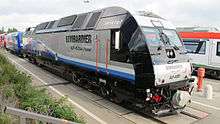 Front view
Front view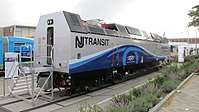 Tail end view
Tail end view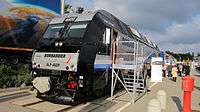 Entry ramp towards cab
Entry ramp towards cab Frontal shot
Frontal shot Pantograph mounted at the rear of the locomotive
Pantograph mounted at the rear of the locomotive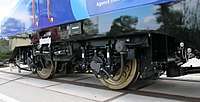 Bogie and suspension detail
Bogie and suspension detail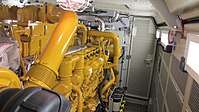 Caterpillar prime mover inside the engine room
Caterpillar prime mover inside the engine room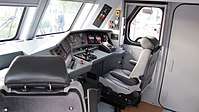 Cab interior
Cab interior Engineer's controls
Engineer's controls
Notes
- Each traction motor drive unit consists of a MITRAC TM 3700F air cooled, three phase asynchronous motor, with a MITRAC GB 3700 helical spur gear and hollow shaft drive.[45]
- Multiple working in dual mode with locomotives of the same class. NJT: Electric mode also with ALP-46, and ALP-44. Diesel mode with NJT PL 42 AC and GP 40.[13]
- "ALP" refers to "American Locomotive Passenger"; "4" indicates the number of axles; "5" refers to the power class, ~5MW; "DP" indicates dual power.[28]
References
- "Bombardier to supply electro-diesel locos". Railway Gazette International. 19 August 2008.
The locomotives will be a dual-mode diesel and AC overhead electric evolution of the ALP-46 electric design in service with NJ Transit since 2002
- "NJ Transit approves FY2011 spending". Railway Gazette International. 19 July 2010.
An order for 100 additional double-deck commuter cars, valued at up to $293·5m, and 9 additional dual-mode locomotives costing $78·8m, was approved on July 15 by New Jersey Transit, exercising options on existing orders with Bombardier.
- "NJT ALP-45 Dual Power". The European Modern Electric Locomotive Database. Railcolor.net. Retrieved 2019-10-05.
- Brugger et al. 2000, p. 561.
- Pernička & Kuchta 2010, pp. 53, 56.
- "3512C HD Petroleum Engine" (PDF), Cat Oil and Gas Specification sheet for 3512C HD engine from CAT
- MITRAC
- Pernička & Kuchta 2010, p. 56, "diesels".
- Pernička & Kuchta 2010, p. 56.
- Brugger et al. 2000, p. 561-2.
- Vitins 2011, Table 1.
- Pernička & Kuchta 2010, p. 56, quote : Operation in multiple is possible - two locomotives being the maximum, and this is also feasible when the locomotives are operating in pushpull mode. It is also possible for ALP-45DPs to run in multiple with ALP-46(A) and other existing NJT (and Exo) vehicles..
- NJ Transit ALP45DP Project Status (2009), Train Interoperability : Summarization (slide 17)
- Canetta & Bikle 2010, Bogie, p.6.
- NJ Transit ALP45DP Project Status (2009), Major characterisitics (slide 5)
- Pernička & Kuchta 2010, p. 55..For a limited time a maximum power of 4,400 kW can be delivered
- Allenbach, Jean-Marc (November 11, 2009). "Fiche documentaire BoBo NJT ALP 45-DP" (PDF) (in French). Retrieved June 11, 2011.
- Brugger et al. 2000, p. 562.
- Pernička & Kuchta 2010, p. 58.
- Vantuono, William (30 May 2012), "NJT's ALP-45DP enters revenue service", Railway Age
- Pernička & Kuchta 2010, "Principal Technical Data", p.53
- Canetta & Bikle 2010.
- Vantuono 2008, p. 18.
- "NJ Transit Orders Modern Rail and Bus Equipmjent". NJ Transit. 14 July 2010.
- "NJ Transit approves capital, operating budgets", www.businessweek.com, 14 July 2010
- DUAL POWER LOCOMOTIVE PROCUREMENT =
- "ALP-45DP electro-diesel locomotive debut". Railway Gazette International. 23 September 2010.
With an overall length of 21·8 m, the dual-mode loco is around 2 m longer than the electric version. Careful design of the internal layout and has helped to keep weight of the four-axle loco to 130 tonnes. ... It has a pair of Caterpillar 3512C engines rated at 2 100 hp arranged symmetrically around the transformer and converter pack to balance the weight.
- Pernička & Kuchta 2010, p. 52.
- "New Jersey Transit unveils first ALP-45 loco", www.railwaygazette.com, 16 May 2011
- "NJ Transit to order more electro-diesels". International Rail Journal. December 8, 2017. Retrieved December 8, 2017.
- "NJT: Bi-level EMUs, more dual-power locos on tap - Railway Age". Railway Age. 2017-11-17. Retrieved 2018-08-27.
- TIMES, The STAT TRADE. "New Jersey orders 17 more ALP-45 locomotives from Bombardier | Supply Chain". www.stattimes.com. Retrieved 2018-07-07.
- "First Carbody Inspected and Approved".
- https://trn.trains.com/news/news-wire/2019/10/08-nj-transit-provides-more-details-on-heritage-units
- "AMT electro-diesel arrives in Montréal". Railway Gazette International. June 16, 2011. Retrieved June 17, 2011.
Montréal commuter rail authority Agence Métropolitaine de Transport took delivery of its first Bombardier-built ALP-45 electro-diesel locomotives on June 9. [...] Built at Kassel in Germany, the locomotive was shipped from Hamburg to Newark, New Jersey, and moved to Montréal under its own power
- "Deux-Montagnes and Mascouche lines - Transitional network from January 2020". REM. Retrieved 2019-09-23.
- Pernička & Kuchta 2010, p. 54, ALP-45DP Design Concept.
- Canetta & Bikle 2010, p. 4.
- Pernička & Kuchta 2010, pp. 53,56.
- Brugger et al. 2000, p. 562, ALP-45DP und ALP-46A Leistungen am Rad.
- Vantuono 2011, p. 29.
- Pernička & Kuchta 2010, p. 54, "electrical equipment".
- Pernička & Kuchta 2010, "traction converter".
- Pernička & Kuchta 2010, p. 55, "transformer".
- Canetta & Bikle 2010, Drive Unit, pp.13-14.
- Pernička & Kuchta 2010, p. 56, "traction motor".
- Vantuono 2008, p. 18, quote : .. to reduce unsprung mass by suspending the traction motors on the trucks, not the axles (like the ALP-46 and newer ALP-46A).
- Pernička & Kuchta 2010, p. 56, "auxiliary".
- Canetta & Bikle 2010, p. 7-8.
- Canetta & Bikle 2010, p. 8, Brake
- Pernička & Kuchta 2010, p. 56, "braking".
- Pernička & Kuchta 2010, p. 56, "compressed air".
- Vitins 2011, Page 4, line 25.
- Vitins 2011, pp. 5, also 9, quote: "..Caterpillar 3512HD high speed engines were chosen for the diesel mode. ... they meet Tier3 exhaust emission standards. A solution is now being prepared to meet Tier4".
- Pernička & Kuchta 2010, pp. 56, 58.
Sources
- Pernička, Jaromír; Kuchta, Tomáš (2010), "Electro-Diesels For New Jersey And Montreal" (PDF), Railvolution, M-Presse plus s.r.o. (6/10): 52–58
- Brugger, P.; Schwendt, L.; Spillman, M.; Vitins, J. (2000), "Die Zweikraft-Lokomotive ALP-45DP – eine Innovation für den amerikanischen Markt", Eisenbahn-Revue (11): 560–563
- NJ Transit ALP45DP Project Status (PDF), NJ Transit, March 2009, archived (PDF) from the original on 25 July 2011
- North America - Passenger - Dual-Powered Locomotive (PDF), Bombardier
- Vantuono, William C. (Aug 2008), "NJT, AMT ready for dual power locomotives", Railway Age: 18, HTML text link via findarticles.com
- Vantuono, William C. (June 2011), "ALP-45DP: Two locomotives in one", Railway Age: 28–29, HTML link via www.raiwayage.com
- Vitins, Janis (October 28, 2011), DUAL MODE AND NEW DIESEL LOCOMOTIVE DEVELOPMENTS (PDF), archived from the original (PDF) on 2012-06-18, retrieved June 26, 2012
- Canetta, Diego; Bikle, Urs (July 2010), "ECO4 SUPERIOR PRODUCTS: DUAL POWERED LOCOMOTIVES ALP-45DP FOR THE NORTH AMERICAN RAILWAYS" (PDF), 12th World Conference on Transport Research (Lisbon)
External links

- "ALP45 pictures from Innotrans 2010 by Bengt Dahlberg", Photobucket
- Allenbach, Jean-Marc (November 11, 2009). "Fiche documentaire BoBo NJT ALP 45-DP" (PDF) (in French). Retrieved June 11, 2011.
- "NJT ALP-45 Dual Power", www.railcolor.net.
- "AMT 13xx Dual Power", www.railcolor.net.
- MITRAC Hybrid The Dual Power Propulsion Chain (PDF), Bombardier.
